
Layouts
Ballykeale
(N: scale 2mm/ft, track gauge 9mm)
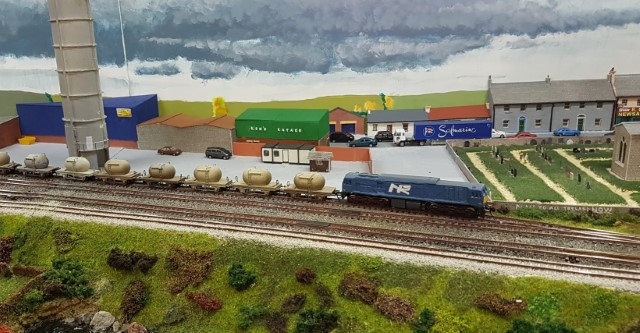 Set in the period 1985-2005, Ballykeale is a fictitious village in the Irish midlands on one of the main lines between Dublin and the west coast. Set in a wooded glen, Ballykeale is Gaelic for narrow town.
Set in the period 1985-2005, Ballykeale is a fictitious village in the Irish midlands on one of the main lines between Dublin and the west coast. Set in a wooded glen, Ballykeale is Gaelic for narrow town.
Although the passenger station closed in 1963, it retains its loop, cement terminal, and junction. Cement and oil trains still stop here to shunt. Many of the intercity passenger trains depicted use converted British rolling stock.
Photos © unknown
Beijiao
(HO: scale 3.5mm/ft, track gauge 16.5mm)
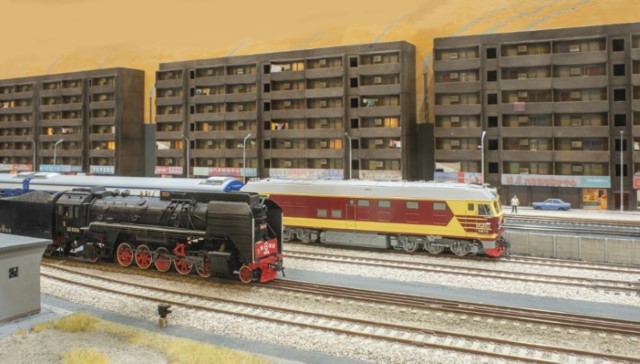 The UK’s only Chinese HO layout is coming to Manchester. Set in the spring of 2001, this unique layout accurately portrays the very last days of mainline steam in China when double-headed 2-10-2’s still hauled long freight trains, although all passenger trains had, by then, been dieselised. Steam fans needn’t worry though, because at the back of the layout there is a 100% steam operated industrial railway featuring double-banked coal trains heading off up a 1/30 gradient to a steelworks off-scene – not something you usually see on a layout! If you want to know more about any aspect of the layout, we will have a friendly front-of-house man to answer your questions.
The UK’s only Chinese HO layout is coming to Manchester. Set in the spring of 2001, this unique layout accurately portrays the very last days of mainline steam in China when double-headed 2-10-2’s still hauled long freight trains, although all passenger trains had, by then, been dieselised. Steam fans needn’t worry though, because at the back of the layout there is a 100% steam operated industrial railway featuring double-banked coal trains heading off up a 1/30 gradient to a steelworks off-scene – not something you usually see on a layout! If you want to know more about any aspect of the layout, we will have a friendly front-of-house man to answer your questions.
Photos © Paul Stapleton
Blakecaster
(On16.5: scale 7mm/ft, track gauge: 16.5mm)
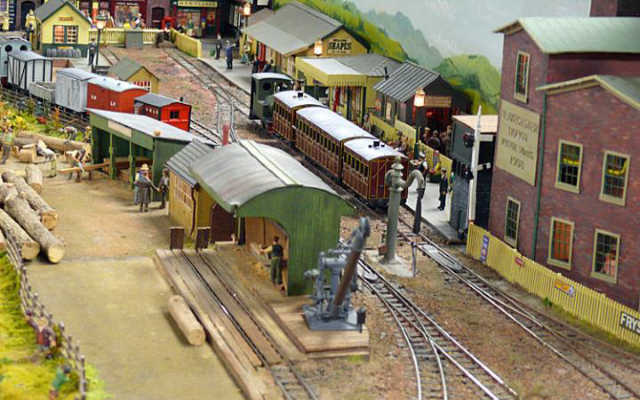 Blakecaster is the terminus of the Staffordshire Moorlands Light Railway. The railway serves a large country estate and the village of Blakecaster which are isolated from the outside world by the infamous Patchway Bog. Blakecaster has limited road connections to the outside world and its main connection is by the narrow gauge railway which was laid along a narrow ridge across the bog.
Blakecaster is the terminus of the Staffordshire Moorlands Light Railway. The railway serves a large country estate and the village of Blakecaster which are isolated from the outside world by the infamous Patchway Bog. Blakecaster has limited road connections to the outside world and its main connection is by the narrow gauge railway which was laid along a narrow ridge across the bog.
Photos © Peter Wilson
Bury, Thorn & Sons
(O: scale 7mm/ft, track gauge: 32mm)
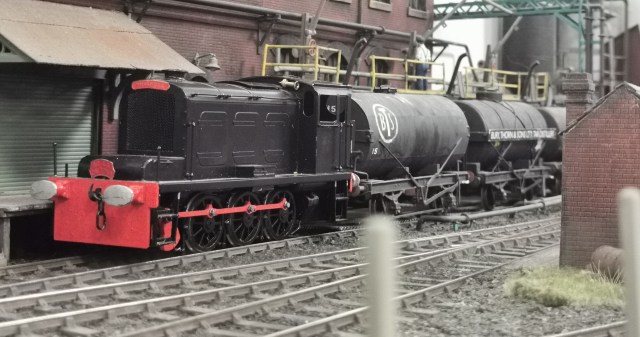 Bury, Thorn & Sons represents a small portion of a fictitious tar distillery set somewhere in the West Riding of Yorkshire in the late 1950’s to early 1960’s, with the rest of the works and the British Rail exchange sidings being located ‘off scene’.
Bury, Thorn & Sons represents a small portion of a fictitious tar distillery set somewhere in the West Riding of Yorkshire in the late 1950’s to early 1960’s, with the rest of the works and the British Rail exchange sidings being located ‘off scene’.
Most of the motive power is R-T-R, repainted into the house colours of desert sand. There are also some kit-built, from a number of suppliers including Judith Edge and Mercian Models, and scratch-built locomotives including a 1929-built Kerr Stuart. The majority of the locomotives are fitted with DCC Sound, with some locomotives operating without sound while they await upgrades as funds allow. The rolling stock is a similar mix of R-T-R and kit, with some of the tank wagons also livered in BT&S schemes.
Traffic consists of inbound tar in square tank wagons, with the refined products leaving in Class ‘A’ & ‘B’ tankers, loaded using the equipment in the rear right hand corner of the layout. General merchandise and barrels are also transhipped in the large warehouse and workshop units along the front of the layout.
If you think you’ve seen this layout before – it featured in the December 2014 edition of Railway Modeller!
Photos © Huw Cairns
Copper Wort
(OO: scale 4mm/ft, track gauge 16.5mm)
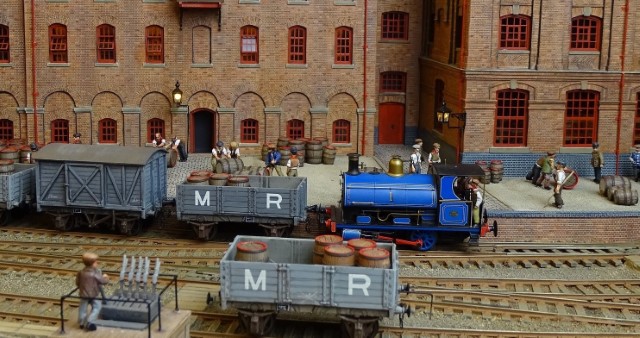 The period modelled, the early 1900’s, represents the high point of the brewing industry in Burton on Trent. An extremely busy town with the bigger breweries establishing their potential with the Midland Railway network with the smaller breweries muscling in between them.
The period modelled, the early 1900’s, represents the high point of the brewing industry in Burton on Trent. An extremely busy town with the bigger breweries establishing their potential with the Midland Railway network with the smaller breweries muscling in between them.
To add substance to what is essentially a little-known small brewery company I have given it a few of its own 0-4-0 locomotives to support the Midland Railway locomotives running through. The layout includes a track plan based on the much larger Worthington’s arrangement to accommodate the numerous Midland Railway and Great Northern open wagons and outside framed MR vans. The buildings are based on the breweries of Bass, Ind Coope, Trumans and others, all based in and around Burton on Trent.
4mm OO gauge built onto a hexagon shaped 6 board arrangement. The track plan is a continuous round and round run with lots of shunting and sidings. 4 of the boards (4’ long on the long edge) contain the complete brewery process. The 5th board is the High Street crossing, shops and houses scene with track running between buildings and the 6th a small fiddle yard. Most of the stock is therefore viewed ‘out front’ in and around the buildings
For more information visit: www.petegossrailwaymodelling.co.uk
Photos © Peter Goss
Dovedale
(O: scale 7mm/ft, track gauge 32mm)
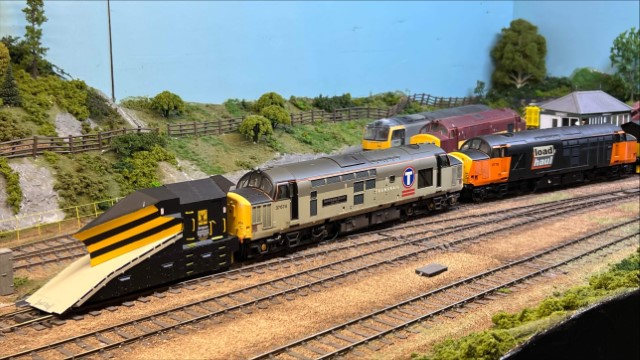 The layout is set between 2000-2003 and is loosely based on Peak Forest. It depicts a quarry loading point and features a loading structure, a fuel point and stabling sidings. The layout has two fiddle yards, allowing through running and a varied amount of interest.
The layout is set between 2000-2003 and is loosely based on Peak Forest. It depicts a quarry loading point and features a loading structure, a fuel point and stabling sidings. The layout has two fiddle yards, allowing through running and a varied amount of interest.
The layout is DCC, and all of our locos are fitted with DCC sound. We run a mix of RTR and kit built wagons, in keeping with the era in which the layout is set.
Photos © unknown
Eaglesham
(OO: scale 4mm/ft, track gauge 16.5mm)
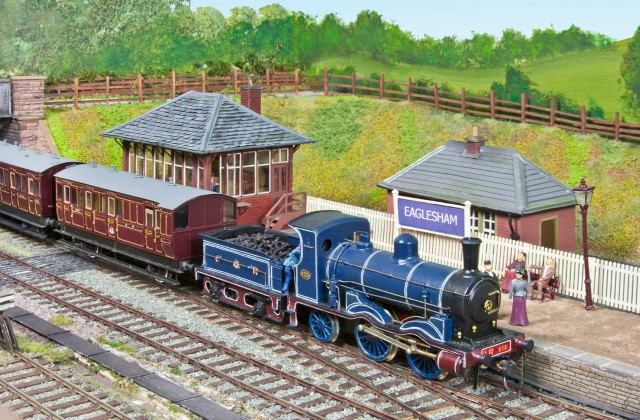 Eaglesham is a fictitious layout based on the track plan of East Kilbride, which was situated some 5 miles away. Set in 1912, the layout portrays the Caledonian Railway in its heyday.
Eaglesham is a fictitious layout based on the track plan of East Kilbride, which was situated some 5 miles away. Set in 1912, the layout portrays the Caledonian Railway in its heyday.
While the stock appearing on the layout is not strictly prototypical it does show the variety of motive power and coaching and wagon stock that operated all over the “Caley” system.
The layout has recently been extended to include, at one end, a materials storage area for the viaduct under construction. While the other end has one viaduct already in use.
All the rolling stock is either kit or scratch built, since there is very little RTR for a pre-group layout. The track is code 75 SMP with hand built pointwork. Most of the buildings are also scratchbuilt from original drawings.
The layout featured in the May 2021 edition of Railway Modeller.
The operators will be only too pleased to answer your questions, feel free to speak to us.
Photos © Railway Modeller
Euxton Junction
(OO: scale 4mm/ft, track gauge 16.5mm)
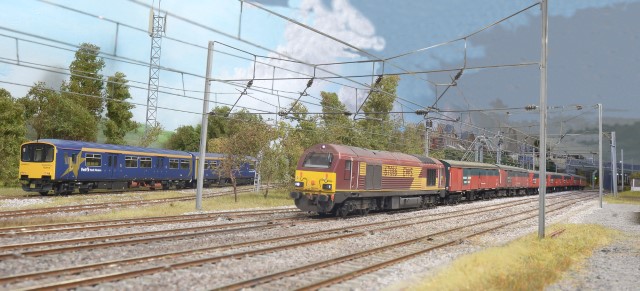 The real Euxton Junction is around seven miles south of Preston where the line to Manchester leaves the West Coast Main Line (WCML), which at this point has both fast and slow lines. Just south of Euxton Junction is Euxton Balshaw Lane station which is located on the slow lines.
The real Euxton Junction is around seven miles south of Preston where the line to Manchester leaves the West Coast Main Line (WCML), which at this point has both fast and slow lines. Just south of Euxton Junction is Euxton Balshaw Lane station which is located on the slow lines.
The layout is set in the period around 2005 when Pendolinos were starting to be introduced and provides the opportunity to see a wide range of rolling stock on the busy WCML. This ranges from Pendolinos, Voyagers, electric loco hauled passenger workings through to local DMUs, lengthy freight trains and infrastructure workings.
As with the prototype, all four tracks on the fast and slow lines have overhead electric wires with a variety of masts and head spans.
All of the signals are auto-controlled with train detection and point interlocking. The layout is operated by DCC with most of the locos having working lights, and a growing proportion having sound.
The line to Manchester sees regular services, which allows workings to be seen crossing the point ladder to reach the slow lines.
We are happy to try and answer any questions about Euxton Junction that you may have.
Photos © Tony Wright
Feldspar
(N: scale 2mm/ft, track gauge 9mm)
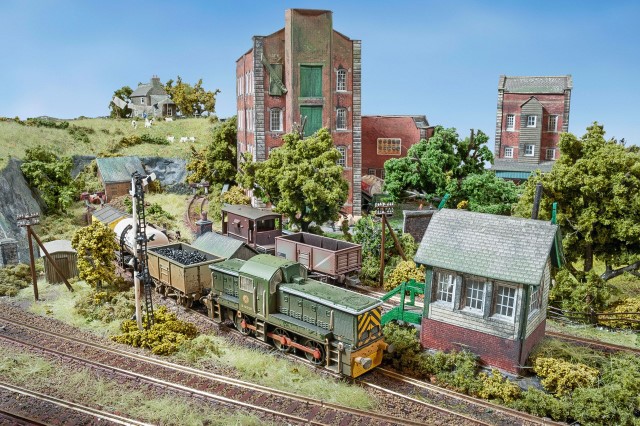 Feldspar is an N gauge coffee table layout, showing a fictional location in 1960s Britain. It has DCC control through a Roco z21 Controller with its own Wi Fi to allow control from a smart phone or iPad.
Feldspar is an N gauge coffee table layout, showing a fictional location in 1960s Britain. It has DCC control through a Roco z21 Controller with its own Wi Fi to allow control from a smart phone or iPad.
The railway station is situated on the outskirts of Feldspar, a small market town somewhere right in the middle of England. The layout is set in the early ’60s; heavy industry – mining for the local granodiorite (a granite-like rock) – has tapered off and the Criollo & Co. chocolate factory is now the town’s largest employer. The railway services the factory and a coal yard, as well as the town.
The original table was recycled from a discarded pine bed. The exhibition version is made from stained white wood and has been made to come apart easily for transportation.
Feldspar made the illustrious pages of “Model Rail magazine” in Summer 2017 and was also featured in Hornby Magazine Summer 2023
Photos © unknown
Hakuho
(Z: scale 1.3mm/ft, track gauge 6.5mm)
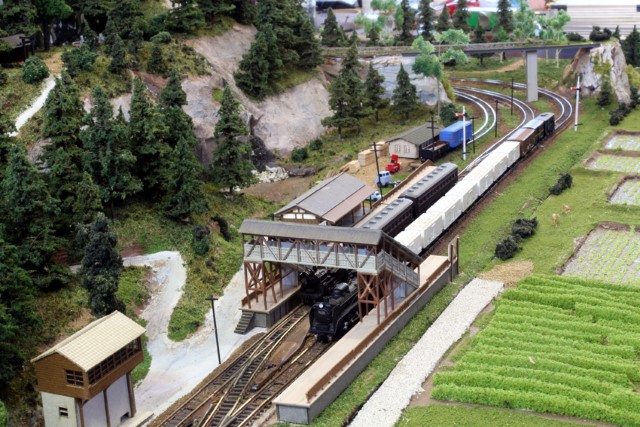 Hakuho represents the rarely seen era of Japanese railways when steam finally gave way to diesel and electric. Also unusual is the setting – a rural area on Japan’s northern island of Hokkaido, where vast forests and wilderness are a complete contrast to the intense, densely populated urban areas like Tokyo and Osaka.
Hakuho represents the rarely seen era of Japanese railways when steam finally gave way to diesel and electric. Also unusual is the setting – a rural area on Japan’s northern island of Hokkaido, where vast forests and wilderness are a complete contrast to the intense, densely populated urban areas like Tokyo and Osaka.
Hokkaido was one of the last strongholds of steam with D51 2-8-2s and C62 4-6-4s still in charge of prestige trains including the famous overnight Sapporo sleeper trains until final withdrawal of steam in 1975.
The main scene is Hakuho station, a small wayside station where two single track main lines meet and diverge, and the local forestry company dispatch their timber products south to the mainland. On the southern approach the lines pass the local golf course, whilst north of the station the outskirts of the town start to appear with very typical, traditional Japanese buildings. Above the station is a locally revered shrine set beside the twin waterfalls.
The layout uses Peco streamline flexitrack with Marklin points set on 6mm MDF baseboard top. The core baseboard has extra scenery boards to extend the foreground, these feature rice paddies and vineyards. The buildings are mainly made from the exquisite pre-cut card kits from Sankei and Advance which really capture the essence of the building styles of Japan. The recent completion of a railway museum at the rear of the layout allows viewing from all four sides.
Locos and Rolling stock are from Tenshodo, Rokuhan and PRM loco. Despite their small size, all the locos have coreless motors, full valve gear, tungsten boiler weights and working lights.
Typical trains include the overnight expresses, local mixed trains with a few wagons and the odd coach and the specialised express fish. Much of the railway scene would look familiar to British modellers with four wheel goods wagons, brake vans and the use of British supplied lower quadrant semaphore signals.
Photos © Kev Smith
Happy Valley
(OO: scale 4mm/ft, track gauge 16.5mm)
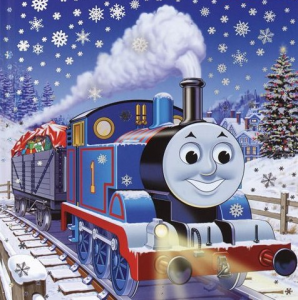 It wouldn’t be Christmas without the little blue tank engine delivering the presents!
It wouldn’t be Christmas without the little blue tank engine delivering the presents!
Photos ©
Hironochō
(N: scale 2mm/ft, track gauge 9mm)
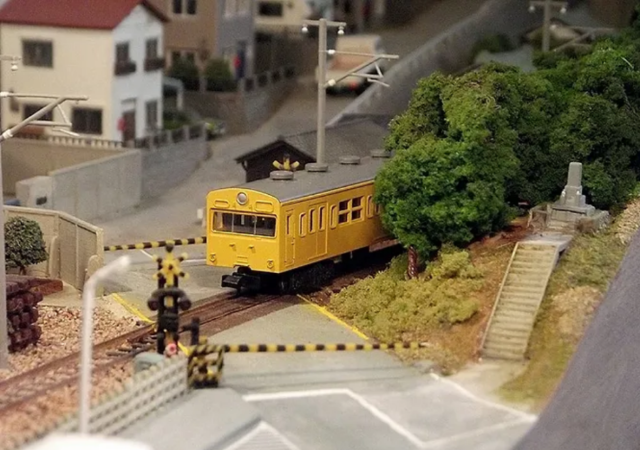 Hironocho represents the terminus of a minor independent railway in Japan. There are several railways of this type in Japan and the model aims to capture some of the typical features of these railways in a very small space.
Hironocho represents the terminus of a minor independent railway in Japan. There are several railways of this type in Japan and the model aims to capture some of the typical features of these railways in a very small space.
In the early twentieth century roads were generally poor and the railway was built to open up the area surrounding the city for development. This proved successful and the area has now become a busy suburb and the railway provides commuters, school children and shoppers access to the city centre. The station has been modernised with a small office block, this being financed by the sale of surplus land released by shortening the platforms to match the two car trains.
At some point in its history the railway was electrified and it is now operated by second hand electric multiple units bought from other, larger railways. There is no connection with the now privatised Japanese National Railways network and the railway is completely self- contained. All maintenance of the rolling stock being carried out in the little depot adjacent to the station.
Photos © Warrington MRC
Kirtley Bridge
(O: scale 7mm/ft, track gauge: 32mm)
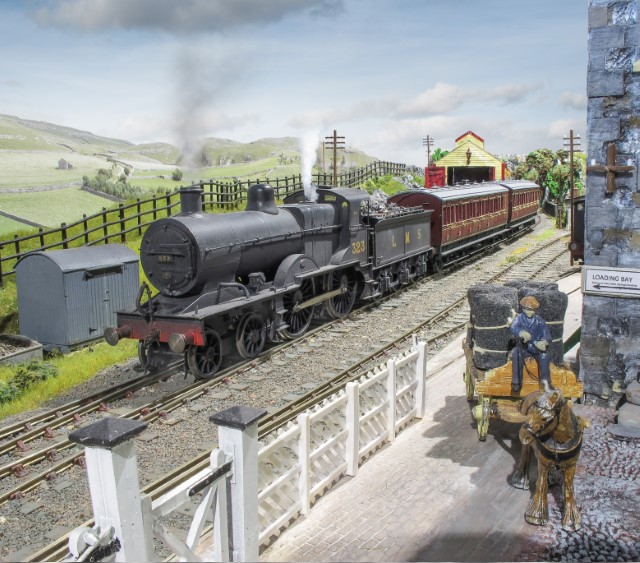 In the Yorkshire Dales, in the closing years of the nineteenth century, a group of local businessmen in upper Wharfedale raised funds to build a light railway to serve their estates, farms, mills and quarries. Trains would run up the valley through the village of Hebden to Kirtley Bridge. Local people too hoped to use the line to reach the nearby cities of the North and West Ridings of Yorkshire for work and travel.
In the Yorkshire Dales, in the closing years of the nineteenth century, a group of local businessmen in upper Wharfedale raised funds to build a light railway to serve their estates, farms, mills and quarries. Trains would run up the valley through the village of Hebden to Kirtley Bridge. Local people too hoped to use the line to reach the nearby cities of the North and West Ridings of Yorkshire for work and travel.
As with many such enterprises the optimism of the early owners did not match the realities of running a railway profitably, and so it was with some relief locally that the Midland Railway Company took over the line even before it was completed. This was soon reflected in the trackwork, station buildings and railway practices that followed, until the LMS took control in 1923. Around this time too, through services began to the small hamlet at Dalehead, prompted by the increased traffic and Bradford Corporation’s plans to build a reservoir at the upper end of the valley”.
The branchline and the growing village of Kirtley Bridge are modelled as they might have been in the late 1930s, when passenger and goods services were both operating fully.
Rolling stock is mostly kit-built or modified RTR, with older second-hand items gradually being replaced. Most trains are steam-hauled using ex-Midland Railway locomotives in pre-war LMS livery. Two classic tender locos – a 2P & 4F – support the work of various tank engines. The quarry has its own mechanical diesel loco.
Buildings are mostly scratch-built using embossed plasticard attached to a framework of thin plywood or strong card, and are based on real examples but adapted to fit their new sites on the layout.
Photos © British Railway Modelling
Kyle of Macallan
(EM: scale 4mm/ft, track gauge 18.2mm)
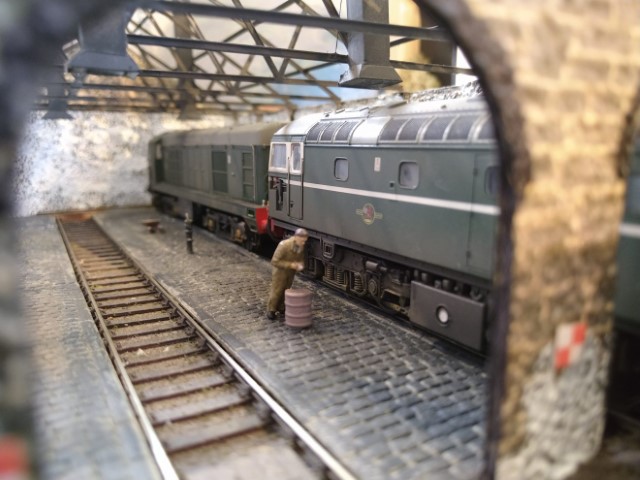 Welcome to the loco shed at Kyle of Macallan, somewhere in the NW Highlands of Scotland. It is September 1966 and steam has gone from the area since June 1962.
Welcome to the loco shed at Kyle of Macallan, somewhere in the NW Highlands of Scotland. It is September 1966 and steam has gone from the area since June 1962.
Where the steam locomotives were once serviced, diesels now rest between duties, though not for long, as the writing is on the wall for the somewhat derelict shed.
The layout is based on, but not a direct copy of, the shed at Kyle of Lochalsh which also, coincidentally, lost most of its roof in a fire shortly after the end of steam.
The layout is DCC controlled. The locomotives are ready to run models converted to EM gauge and are sound fitted.
Photos © Adrian Walby
Legomas
(L scale – about 10mmm/1ft, track gauge 37.5mm)
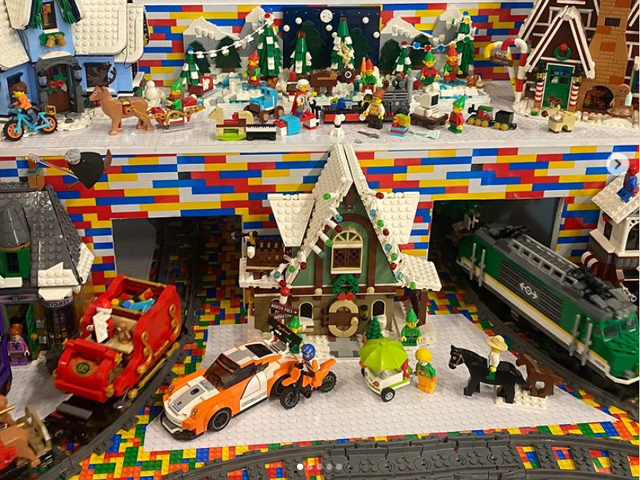
We have had an addiction for Lego since we were tiny and during the Covid lockdowns Lego was an incredible escape, starting from Christmas houses, and growing and growing! I was even bought the Lego Titanic for my 50th birthday, but at at over 6 foot long it is too big to include at exhibitions.
We then merged our Lego fascination with our other passions of model railways and Christmas – LEGOMAS was born!
We were told by anybody who saw our collection that we should exhibit it. Already we have brought a smile to hundreds of children’s faces and also many, many parents, grandparents and even just adult train enthusiasts. It’s been hard work, but exceptionally rewarding.
Photos © Leigh MRS
Lisworth Bay
(N: scale 2mm/ft, track gauge 9mm)
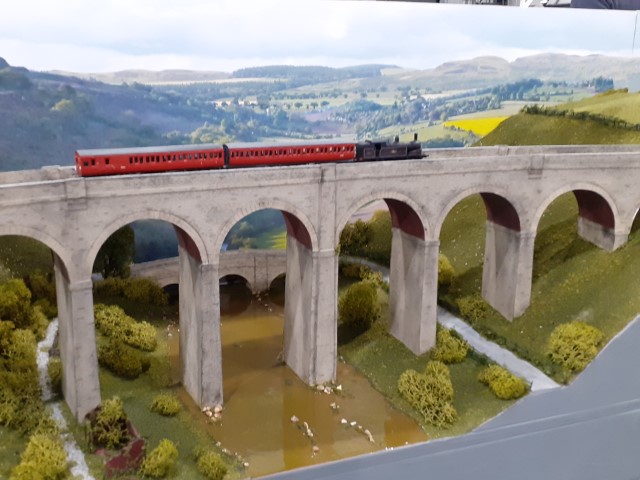 The London and South Western Railway forged its way south-west during the railway age of the 19th century, sprouting branches to coastal towns on its way; Lisworth Bay was one of these. Although originally a terminus, during the Great War the line was extended to serve a nearby ordnance depot and the road access to the station was interrupted by the installation of the level crossing across this extension. Improvements in roads in the post-WWII years also saw a decline in its use and the extension was due to be lifted during the 1950’s. However, the increased tension of the Cold War years encouraged the government to retain it as a precautionary measure. The branch was “rationalised” shortly after nationalisation and became a single line, the track-plan simplified and part of the original down line retained only as a storage siding. Trains are typical of those seen on the region; portions of express passenger services, split at various stations en route, reach the terminus alongside local passenger workings, freight, parcels, newspaper and milk traffic. The whole branch to Lisworth Bay, was condemned to be closed as part of the Beeching Report and trains last ran in the early autumn of 1966. The trackbed has recently become a cycle route.
The London and South Western Railway forged its way south-west during the railway age of the 19th century, sprouting branches to coastal towns on its way; Lisworth Bay was one of these. Although originally a terminus, during the Great War the line was extended to serve a nearby ordnance depot and the road access to the station was interrupted by the installation of the level crossing across this extension. Improvements in roads in the post-WWII years also saw a decline in its use and the extension was due to be lifted during the 1950’s. However, the increased tension of the Cold War years encouraged the government to retain it as a precautionary measure. The branch was “rationalised” shortly after nationalisation and became a single line, the track-plan simplified and part of the original down line retained only as a storage siding. Trains are typical of those seen on the region; portions of express passenger services, split at various stations en route, reach the terminus alongside local passenger workings, freight, parcels, newspaper and milk traffic. The whole branch to Lisworth Bay, was condemned to be closed as part of the Beeching Report and trains last ran in the early autumn of 1966. The trackbed has recently become a cycle route.
The layout is modular with the fiddle-yard at 90° to the scenic section. The original format featured only the station approach and terminus but has been extended by the addition of two more boards, the first featuring a farm and the second a 60’ high viaduct over the River Lis.
Photos © Steve Flint
Raven’s Ravine
(OO9: scale 4mm/ft, track gauge 9mm)
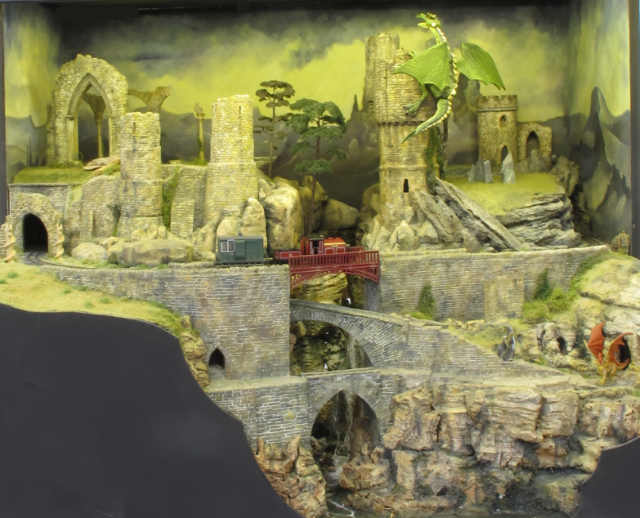 Raven’s Ravine is a working OO9 diorama set in a fantasy landscape. The main feature of the model is the ravine, which is crossed by three bridges. Beyond the railway, the castle ruins dominate the scene with catacombs and caves where dragons can be found! To complete the diorama a primitive landscape has been hand painted to form the bac drop, and a few special effects have been included to add to the surreal and theatrical feel of the model.
Raven’s Ravine is a working OO9 diorama set in a fantasy landscape. The main feature of the model is the ravine, which is crossed by three bridges. Beyond the railway, the castle ruins dominate the scene with catacombs and caves where dragons can be found! To complete the diorama a primitive landscape has been hand painted to form the bac drop, and a few special effects have been included to add to the surreal and theatrical feel of the model.
Alongside the model, the owner will be demonstrating the modelling techniques used. For more information visit the “Attractions” page.
Photos © David Wright
Reevy Road West
(OO: scale 4mm/ft, track gauge 16.5mm)
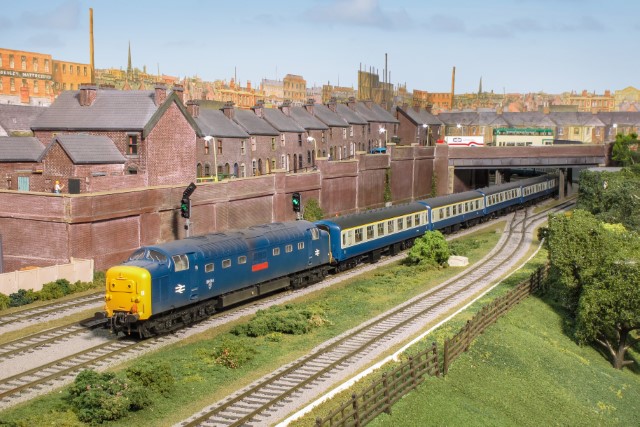 The layout was acquired by the Bradford Model Railway Club in 2015 in a very basic form, comprising only the front section, no fiddle yard and very basic scenery. A new fiddle yard has been constructed to permit continuous running, and the layout has been completely re-wired to allow DCC control – the first club layout to have this fitted.
The layout was acquired by the Bradford Model Railway Club in 2015 in a very basic form, comprising only the front section, no fiddle yard and very basic scenery. A new fiddle yard has been constructed to permit continuous running, and the layout has been completely re-wired to allow DCC control – the first club layout to have this fitted.
The scenery is polystyrene blocks covered with lightweight Polyfilla painted a dark brown and given several coatings of Woodlands scenic flock. The numerous trees are from the Model Tree Shop. The scenic section track is Peco code 75 with code 100 for the fiddle yard. The original ballast has been very painstakingly removed and relayed using Woodlands Scenic fine grey, then lightly weathered.
Buildings in the town are laser cut wood painted and detailed. The industrial buildings have been scratch built using cardboard and plasticard. The backscene is a painted-on sky colour which is enhanced using a printed townscape montage cut from various Townscene sheets.
The layout is normally run in the BR blue diesel era 1976-85. Where possible prototypical to the period trains are run. All the locomotives and stock are from Bachmann, Hornby and Dapol, the majority are DCC sound fitted with detailed buffer beams and lightly weathered often with extra detail. Tail lamps and pipes may also be seen on the last wagons/coaches of all the trains.
The layout stands at 5ft, bringing it near to eye level. The 2ft high backscene together with the covered ends mean that the operators cannot be seen and the fiddle sidings are not visible, which all makes for a good display.
For more information visit https://bradfordmrc.org/
Photos © Hornby Magazine, British Railway Modelling
Slattocks Junction
(P4: scale 4mm/ft, track gauge 18.83mm)
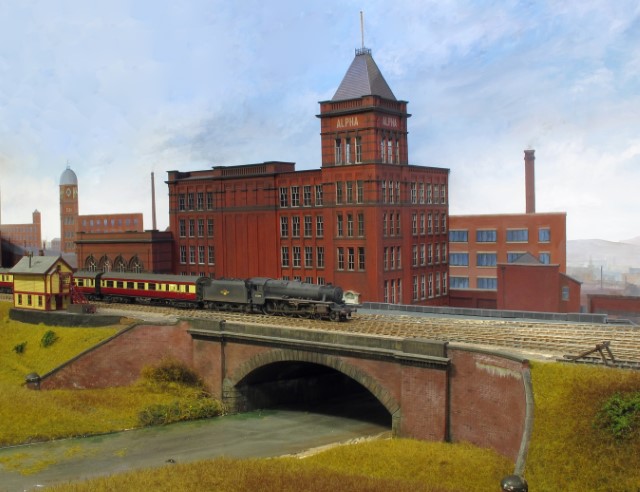 The real Slattocks is north of Manchester between Middleton and Castleton on the Calder Valley line (Manchester Victoria – Rochdale – Summit Tunnel – Leeds). Our model is not a copy of what is actually there, but is an amalgam of features from the area, including the junction itself and the Rochdale canal, which forms the boundary between the country end and the town end of the layout.
The real Slattocks is north of Manchester between Middleton and Castleton on the Calder Valley line (Manchester Victoria – Rochdale – Summit Tunnel – Leeds). Our model is not a copy of what is actually there, but is an amalgam of features from the area, including the junction itself and the Rochdale canal, which forms the boundary between the country end and the town end of the layout.
The buildings are models of buildings in the Manchester area, the station shops, for example, are from Wilbraham Road, Chorlton. The centre of the layout is dominated by Alpha Mill, based on Warwick Mill in Middleton, and hides the layout’s control panel.
The mill is constructed entirely from laser cut card on a 3mm plywood frame and took 18 months to complete. Each wall has 4 layers of different thicknesses to achieve the relief required to detail the brickwork. All the brickwork is engraved into the card by the laser and the brick pattern conforms to the prototype photos and drawings as closely as possible.
The layout is nominally set in Sept 1957, and the rolling stock is appropriate for the period 1955–1960. This allows an interesting variety from pre-grouping (obviously in the BR livery of the period), through to BR standard classes. Most of the rolling stock is kit built, and, where possible the train formations are prototypical.
The lighting on the layout is experimental and still under development. It is designed to portray an autumn day on the edge of the Pennines, including a changing sky with moving clouds and thunderstorms!
The layout has an unusually high backscene, hand painted in acrylics by former member Mike Raithby, and rather low fascia boards, inspired by the platform canopies at Littleborough station. This is to concentrate the viewers’ attention on the model and prevent them from being distracted by the operators. The layout is designed to be viewed from behind the barrier.
Photos © Karl Crowther
Smethurst Junction
(OO: scale 4mm/ft, track gauge 16.5mm)
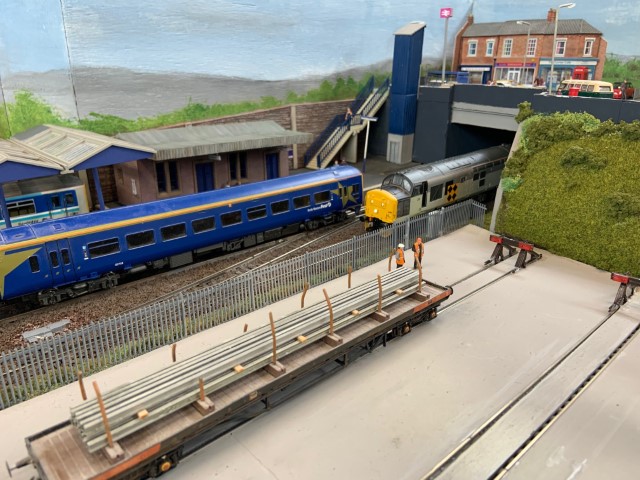 Set in the northeast of Manchester, Smethurst Junction depicts a small suburban branch line with a terminus station and freight facilities from the late 1990’s to the present day. Frequent passenger services are provided by a variety of diesel multiple units operating from Manchester Victoria and beyond. Train loads of steel and general merchandise are for the distribution depot and additional sidings are for engineers’ traffic. A small locomotive servicing point is on the lower-level yard. The loop line allows other freight traffic to run round and gain access to another terminal further along the line.
Set in the northeast of Manchester, Smethurst Junction depicts a small suburban branch line with a terminus station and freight facilities from the late 1990’s to the present day. Frequent passenger services are provided by a variety of diesel multiple units operating from Manchester Victoria and beyond. Train loads of steel and general merchandise are for the distribution depot and additional sidings are for engineers’ traffic. A small locomotive servicing point is on the lower-level yard. The loop line allows other freight traffic to run round and gain access to another terminal further along the line.
Photos © Hazel Grove & District Model Railway Club
The Andeerline
(HOm: scale 3.5mm/ft, track gauge 12mm)
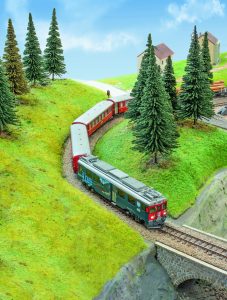 The real town of Andeer is a spa in the Graubunden region in South East Switzerland. Whilst the town has no actual rail connection, in reality, the Rhaetian Railway (RhB) operates through Thusis situated to the North on the ‘Via Mala’.
The real town of Andeer is a spa in the Graubunden region in South East Switzerland. Whilst the town has no actual rail connection, in reality, the Rhaetian Railway (RhB) operates through Thusis situated to the North on the ‘Via Mala’.
The Andeerline is a set of modular stations which can be set up in a variety of formations. At this exhibition it will be shown in its fully extended format with a ‘scenic fiddleyard’ at one end and a terminus, based on Tirano in Italy, at the other. Between them is a junction station, based on Pontresina, and two fictitious through stations – Andeer and Bivio. Operations include mixed passenger trains, Panoramic Expresses and heritage excursions.
Baseboards are made from plywood and the track is Peco. All the points are motorised and the layout is fully signalled. All rolling stock is Bemo.
DCC is provided by a Roco Z21 unit with various other manufacturers components performing the necessary actions of detection and accessory control. It is operated using the Z21 app on smartphones and tablets allowing wireless ‘walk around’ operation. The person in overall control uses a PC which runs Railroad and Co software as a centralised signalling centre to set the routes for the drivers and generally try to keep order. If necessary trains can also be operated automatically.
Whenever possible, we encourage visitors to have a go at operations under the guidance of the operating team. Please feel free to ask questions and don’t be shy in asking for a drive!
Photos © Peco
The Warren
(OO: scale 4mm/ft, track gauge 16.5mm)
 The Warren started out as a fill-in project on a spare baseboard for a simple branch line, based in the south west, where we could run our Dapol single car DMU’s. It had to be quick to complete using a few new ideas for scenery construction, have a beach scene, be able to
The Warren started out as a fill-in project on a spare baseboard for a simple branch line, based in the south west, where we could run our Dapol single car DMU’s. It had to be quick to complete using a few new ideas for scenery construction, have a beach scene, be able to
operate fully automatically, and be suitable for exhibition use. The result is generally based on the Looe branch but also replicate pictures we had seen in books about Cornish branches. In many cases, the platforms were simple affairs of with a GWR ‘pagoda’ serving as a waiting room. Goods facilities were generally not provided but we have given the station a single siding, used by the occasional engineer’s train or to leave crippled china clay wagons.
The track is C&L wooden sleepers with a Peco bullhead point which is operated by a servo motor. The few buildings are Wills kits which fit the rural location quite nicely and the overbridge is Wills plasticard. A variety of scenic materials have been used to create the earthworks,
including insulation foam, hanging basket liner and various items from the Woodland Scenics range.
The main branch train service is in the hands of a variety of single car DMUs with the occasional 2-car from further afield. All units are fitted with DCC sound from Digitrains or Legoman, and these are operated automatically by a laptop under the layout. A manual override switch on the
rear of the layout stops operation of the units to allow running of freight trains. The DCC system used is from MERG.
WC Boggs & Sons
(O: scale 7mm/ft, track gauge: 32mm)
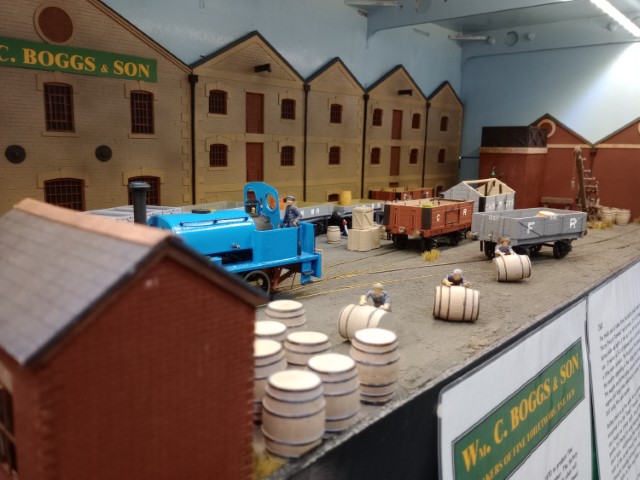 Wm. C. Boggs and Son was founded in 1870 to produce fine toilet wares for the discerning customer. The factory was rail connected from day one until the late 1960’s when rail gave way to road transport. While being generally overshadowed by their larger competitors the factory did eventually become quite famous in 1970 due to a comedic documentary which was remade as “Carry On at Your Convenience”. Little remains of the works as it closed in 1982 and was turned into a housing estate shortly after.
Wm. C. Boggs and Son was founded in 1870 to produce fine toilet wares for the discerning customer. The factory was rail connected from day one until the late 1960’s when rail gave way to road transport. While being generally overshadowed by their larger competitors the factory did eventually become quite famous in 1970 due to a comedic documentary which was remade as “Carry On at Your Convenience”. Little remains of the works as it closed in 1982 and was turned into a housing estate shortly after.
The track plan is adapted from one in the Gauge O Guild’s Small layout book. It works as 5-3-3 inglenook with a kick back siding to add a little more interest. The wagons are sorted using coloured barrels, small in the wagons and large ones selected at random from a bag. Control is DCC using the Lenz system.
Rolling stock is, on the whole, kit or scratch built with the exception of a few “Dapol” Terriers. The location of the factory moves around the country as I swop stock! Due to the tight radius of the points I’m limited to using wagons shorter than 16ft (scale) and short locos. The enclosed viewing area and the tight radii of the curves meant that I have had to develop my own automatic coupling system as none of the others worked. This is now available in 7mm and 4mm under the “Flippem Automatic Coupling” brand.
The track work is PECO set track. Points are controlled manually using “Blue” point actuators mounted directly under the base boards. Ballast is mainly play-sand and PVA, with OO granite chips where the track is exposed. The buildings are a mixture of Skytrex, LCut and 3D printed.
Photos © Marc Dobson
Winter Overcotes
(OO9: scale 4mm/ft, track gauge 9mm)
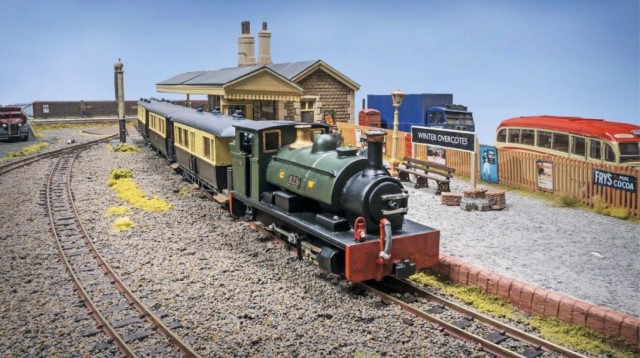 The lovely county of Barsetshire, home of eccentric clerics and squires, was first immortalised by Anthoy Trollope in his six novel series Chronicles of Barsetshire, written between 1854 and 1867. In the mid-twentieth century, the stories of the same families were taken up again by Angela Thirkell, a cousin of Rudyard Kipling, depicting the decaying life of the country gentry with gentle humour. Both generations of novels provided the inspiration for this layout.
The lovely county of Barsetshire, home of eccentric clerics and squires, was first immortalised by Anthoy Trollope in his six novel series Chronicles of Barsetshire, written between 1854 and 1867. In the mid-twentieth century, the stories of the same families were taken up again by Angela Thirkell, a cousin of Rudyard Kipling, depicting the decaying life of the country gentry with gentle humour. Both generations of novels provided the inspiration for this layout.
Winter Overcotes lies in East Barsetshire, on what used to be the Great Western mainline from Paddington to Bristol. In the late 1900s the Warings, of The Priory, funded the building of the East Barsetshire Light Railwayt to connect the pastoral riches of the Woolram Valley with the cathedral city of Barchester and beyond, via a junction with the mainline at Winter Overcotes.
The line was from its opening a common carrier and successfully resisted closure even after the Second World War, partly because of the ferocious support of the present day Warings, allied to other county powers who still make money out of the line: landowner and farmer Lord Bond of Stoke Park, agricultural giant Macpherson of Amalgamated Vedge, and Samuel Adams, local industrialist and former Labout MP, and his wife Lucy (nèe Marling), herself a market gardener on the grand scale.
Our scene depicts Winter Overcotes Junction in about 1952 with the rolling stock in a mixture of pre- and post-nationalisation liveries, some signs of wartime austerity, and Mrs Adams’ market garden flourishing beside the line.
Photos © Unknown
Wolfe Lowe
(O: scale 7mm/ft, track gauge: 32mm)
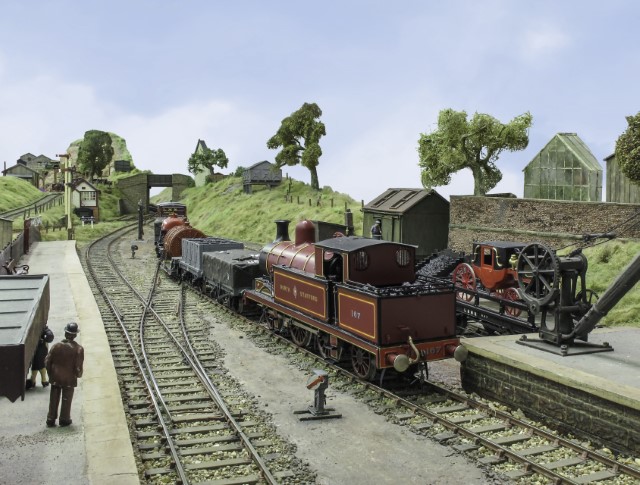 Wolfe Lowe is a small terminus station located somewhere in Staffordshire Moorlands. The era is LMS pre-grouping but ambiguous as to which constituent company in order to allow the layout to accommodate Midland, LNW and North Staffordshire stock. The layout incorporates a small sandstone quarry and iron ore mine. In the quarry, wagons are filled with stone and hauled by a private railway locomotive down to a headshunt where they are exchanged with mainline railway company engines for the final leg into the station. The ore is delivered to wagons using a mine train which operates fully automatically – loading, moving and unloading without the touch of human hand!
Wolfe Lowe is a small terminus station located somewhere in Staffordshire Moorlands. The era is LMS pre-grouping but ambiguous as to which constituent company in order to allow the layout to accommodate Midland, LNW and North Staffordshire stock. The layout incorporates a small sandstone quarry and iron ore mine. In the quarry, wagons are filled with stone and hauled by a private railway locomotive down to a headshunt where they are exchanged with mainline railway company engines for the final leg into the station. The ore is delivered to wagons using a mine train which operates fully automatically – loading, moving and unloading without the touch of human hand!
The layout’s track plan is inspired by Leintwardine from Ian Rice’s book Light Railway Layout Designs. Train control is by conventional DC although concessions have been made to modern technology with the use to servos to operate the points and Raspberry Pi in overall control of the automatic operation of the two foot gauge mine railway. The Pi communicates with a network of 5 micro-controllers 2 of which operate the servos which perform the loading and unloading of mine wagons. Another micro-controller senses the train’s position and controls its direction and speed.
Photos © Andy York (BRM)
YORK
(2FS: scale 2mm/ft, track gauge 9.42mm)
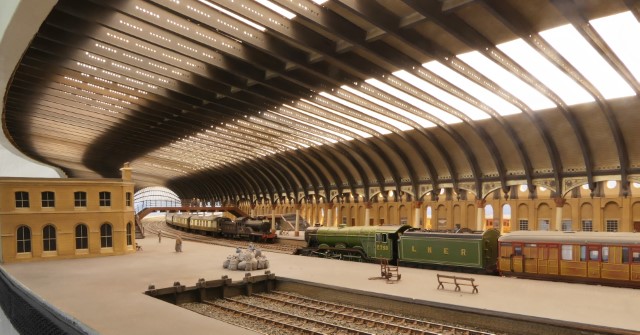 YORK is a 2mm/ft finescale model railway layout of York Station as it was in the late 1930s. It features the view of the INSIDE of the magnificent overall roof as though you were standing on the platform.
YORK is a 2mm/ft finescale model railway layout of York Station as it was in the late 1930s. It features the view of the INSIDE of the magnificent overall roof as though you were standing on the platform.
The whole railway system at York would be a massive project (even in 2mm scale) with 7 manual signal boxes with a total of 846 levers just for the station area, but the main concourse of the station under the roof was just 800ft long, which is a very practical size in 2mm/ft. The open air parts of the platform at either end can be viewed through the ends of the roof, and the entrance building is ‘off scene’ leaving just the view from the main platform.
How this could actually be achieved required much thought and many experiments with mock ups. Fortunately, the Network Rail webshop produced drawings and plans to enable an accurate representation to be drawn up on CAD and cut from palsticard on my Silhouette craft cutter. Once the mock-up has shown that the idea for the model was sound, nickel silver etches for the roof support girders were designed, and many, many hours later, the roof began to take shape.
Since virtually all of the trains would stop at the platform and then move away again, all the locos had to have smooth slow running and jerk-free starts. This is achieved by reduction gears with typically a 1:100 ratio. This means that the top speed of all the locos is only about a scale 30 mph, but since there was a 20mph speed limit through the station in the 1930s, this isn’t a problem – it’s prototypical!
For more information about how the model was created, visit www.this-is-york.com
Photos © Peter Kirmond